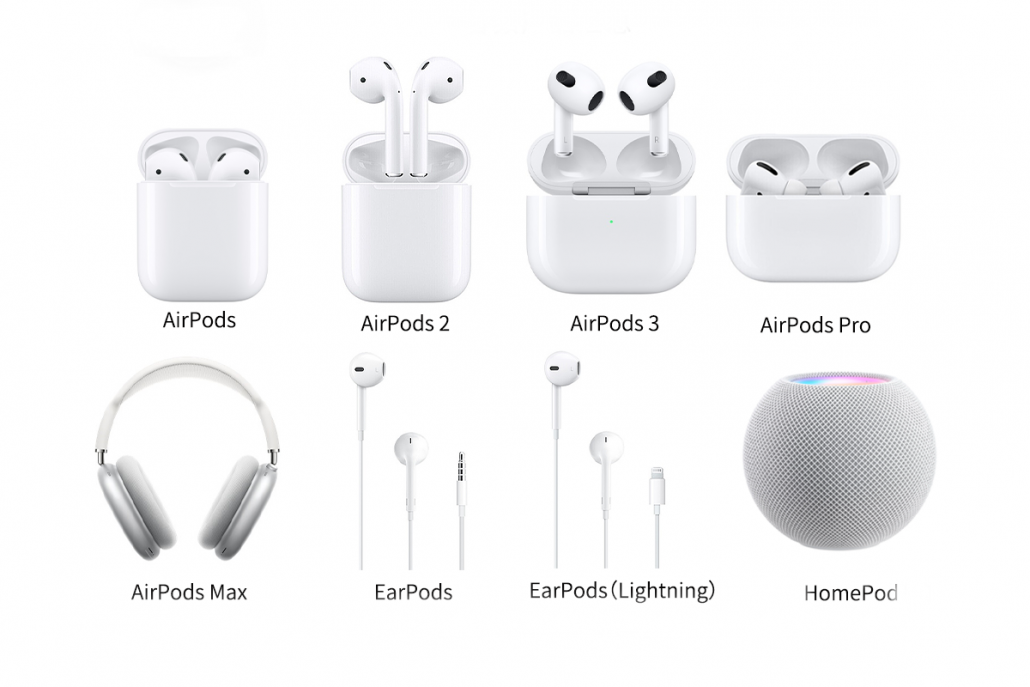The launch of AirPods has opened a new era of true wireless Bluetooth headsets. However, it has been 6 years since the first generation of AirPods was launched. The market of TWS headsets has shifted from the basic “portable, true wireless” to the more demanding “high-quality sound, High Fidelity” music pursuit.
In order to achieve a high-fidelity lossless music experience, it is necessary to support a higher Bluetooth transmission rate, but the traditional Bluetooth 2.4GHz can only achieve a maximum transmission rate of 3Mbps, which is far from satisfying the minimum transmission rate of 10Mbps for Hi-Res lossless music. Require.
Apple may be the first to achieve 8Mbps transmission rate for its Bluetooth audio products, so as to achieve a closed-loop experience of lossless listening for its own audio products.
Apple continues to pursue lossless sound quality. At present, Apple’s official music software Apple Music already supports Dolby Atmos and lossless audio, which is also releasing a signal that Apple will promote all its audio products to support lossless music listening experience . In order to promote the full range of audio products to support lossless listening, it is necessary to upgrade the Bluetooth technology.
Like many wireless communication protocols, Bluetooth technology uses multiple radio channels. Bluetooth Low Energy divides the 2.4GHz ISM radio band into 40 RF channels spaced 2MHz apart, while Bluetooth BR/EDR divides it into 80 channels.
The 2.4GHz ISM band has a frequency range of 2.400-2.4835 GHz. The ISM band is mainly open to the three major institutions of industry, science and medicine. The ISM band belongs to the Free License band. The 2.4G ISM frequency band is the only frequency band that is not licensed in all countries, and only needs to comply with the specified transmit power. We are familiar with wireless LAN, Bluetooth, ZigBee and other wireless networks, all of which can work in the 2.4GHz ISM frequency band.
Although the 2.4GHz ISM frequency band has a wide range of applications, with the expansion of application scenarios, the 2.4GHz Bluetooth technology has limitations in the transmission rate. In terms of transmission rate, the classic Bluetooth is up to 3Mbps, and the low-power Bluetooth BLE is up to 2Mbps. This leads to the fact that although manufacturers use 2.4GHz Bluetooth, they need to increase the 2.4GHz Bluetooth transmission rate through team research to provide users with better. User experience, where Apple is the leader in this regard.
Apple MacBook, iPad, iPhone, Apple Watch and other products have supported higher transfer rates at 2.4GHz. Up to now, Apple MacBook, iPad, iPhone, Apple Watch and other products have supported a higher transmission rate of 4Mbps/8Mbps in Bluetooth 2.4GHz.
At the same time, it can be seen from the data that the current Apple AirPods series of true wireless headset products and audio products have not been upgraded to support higher transmission rates like other Apple products, but maintained at 3Mbps of traditional 2.4GHz Bluetooth.
Of course, in addition to the AirPods series of headphones and audio products, there is no upgrade yet. Through the public data of PCTEST, we know the Bluetooth transmission rate data of the AirPods series products.
The maximum transmission rate of Bluetooth 2.4GHz used by Apple’s AirPods series is still only 3Mbps, which cannot match the rate of other Apple devices. Therefore, it is currently impossible to achieve a lossless listening experience on AirPods and other products.
Taking CD audio files as an example, if lossless audio transmission is performed in PCM format, 44.1kHz/16bit stereo requires a data throughput of 1.4Mbps. Although the maximum transmission rate of classic Bluetooth and BLE exceeds the transmission requirement of 1.4Mbps, considering that Due to factors such as frame interval time, frame overhead, link control information, retransmission arrangement, and coexistence with other wireless technologies in the Bluetooth transmission process, today’s Bluetooth technology is still unable to meet entry-level lossless audio transmission. Apple also mentioned this issue in a previous interview.
As the sales of TWS earphones continue to grow, consumers’ requirements for wireless earphones continue to increase, and TWS earphone products have also shifted from the basic “portable, true wireless” to the more demanding “high-quality, high-fidelity” music pursuit.
Consumers’ requirements for sound quality of wireless audio products are gradually increasing, but the current rate of Bluetooth transmission technology is completely unable to meet the requirements for transmitting high-fidelity and lossless sound quality files. Therefore, it is necessary for Apple to apply the Bluetooth technology of other products to its audio products. The AirPods series supports transfer rates of 8Mbps and above, and there are signs in the near future that Apple will adopt higher transfer rates on its audio products.
Apple AirPods series, or will support 2.4GHz maximum transmission rate of 8 megabits when the second generation of AirPods Pro is released
When the TWS earphone market first broke out, users were just pursuing a more portable listening experience brought by true wireless earphones. However, as the TWS earphone market becomes increasingly saturated, more and more users want to listen to TWS earphones. To lossless music, but the requirement of “experience lossless music on TWS headphones” is obviously limited by the transmission speed of Bluetooth 2.4GHz technology and cannot be achieved.
Apple’s VP of Acoustics, Gary Geaves, discussed the limitations of Bluetooth and other factors that hinder the sound quality of the AirPods in a recent interview. Although the AirPods 3 have replaced the AirPods 2, this model has limited data transmission due to the limitations of Bluetooth technology. The maximum rate can only reach 3Mbps, which cannot achieve a qualitative leap in sound quality, which makes AirPods 3 less popular than AirPods Pro.
In order to improve the sound quality of the earphones, the earphones need to support music files with larger file sizes. However, the limitation of the current Bluetooth technology has led to the maximum data transmission rate of AirPods 3 being only 3Mbps, while Apple’s new high-resolution music Hi- Res Lossless requires speeds of up to 10Mbps, which makes it necessary for Apple’s technical team to upgrade Bluetooth technology.
After realizing that Bluetooth technology limits the upgrade of AirPods headsets, Apple’s vice president of acoustics Gary Geaves hinted in an interview that “Apple will soon have innovations in Bluetooth transmission rates because Apple wants more bandwidth.” In other words, Apple currently wants more bandwidth, and its most important purpose is to improve the audio to bring a better listening experience, while paving the way for future higher-band Bluetooth transmission.
Apple previously listed Bluetooth 6GHz as the future development trend of its products in an interview, but at this stage they may prioritize AirPods to achieve higher transmission rates under Bluetooth 2.4GHz. Apple is expected to support the 2.4GHz maximum transmission rate in audio products in the next step, and plans to launch 6GHz Bluetooth in the future to obtain more bandwidth.
Apple will most likely make changes to the Bluetooth transfer rate on the second-generation AirPods Pro to achieve better audio bandwidth for higher sound quality. Then with the launch of the second-generation AirPods Pro, the sound quality ceiling of TWS headphones will be broken again. Apple’s second-generation AirPods Pro will be released around September 2022, and the product has been evaluated for delivery.
A summary of Apple’s audio products of all generations, continuous launch, and the status of audio products is becoming more and more important
Since 2012, Apple has successively launched a number of independent audio products to match its own iPhone and MacBook systems to achieve the purpose of Apple’s ecological closed-loop experience.


